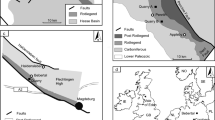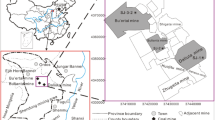Abstract
Tertiary to Early Quaternary fine-grained marine sedimentary rocks (soft rocks) of the Central North Island, New Zealand, suffer from high erosion rates and slope instability. In geomechanical laboratory tests they exhibit a range in behaviour which straddles the division between overconsolidated soils and rocks. Direct application of published classification systems to predict performance has been unsuccessful for New Zealand soft rocks so far. Mineralogical composition does not vary greatly between ages and locations, in contrast to geomechanical parameters. Most constituents are detrital, no cement has been precipitated and post-depositional diagenetic alterations are negligible. Mineralogy does not comprehensively account for the geomechanical performance of these rocks. More direct influence is exerted by their microfabric. Basic building blocks of the fabric are detrital grains, clay microaggregates, microfossils and larger clay aggregates. Grains, microaggregates and fossils are mechanically stable, but larger aggregates exhibit varying degrees of stability. The geometric arrangement of structural elements can be described within a framework of three fabric types, the skeletal, matrix and turbostratic microfabrics, which form an evolutionary sequence related to the loading history of the deposits. Some geomechanical characteristics of the rocks, particularly strength, cohesion and durability, correlate well with the fabric type classification. In all fabrics, contact between structural elements involve clay, and its physico-chemical properties are important for their performance under stress. The fabrics are dynamic and adjust to changing stress conditions by re-arranging their constituents and contact configurations. Their response to loading and slow unloading during regional uplift is quasielastic, resulting in a loss of stress memory. During rapid unloading by erosion or excavation stress relief fractures parallel to topography can develop. Aggregates and connector assemblages form weak links in the fabrics. They are less competent in their response to stress and wetting and drying than other structural elements. Their breakdown decreases effective grainsize, average pore size and permeability, and initiates further disintegration of the fabric.
Résumé
Les roches sédimentaires marines à grain fin du Tertiaire ou début Quaternaire dans le centre de l'Ile du Nord en Nouvelle Zélande sont très profondément érodées et présentent des pentes instables. Leur comportement aux essais mécaniques en laboratoire les place à cheval entre les sols surconsolidés et les roches. L'application directe des classifications connues ne permet pas de prévoir le comportement de ces roches «tendres». La composition minéralogique varie peu en fonction des âges et des emplacements, contrairement aux paramètres mécaniques. La plupart des composants sont détritiques, aucun ciment n'a précipité, et les altérations postérieures au dépôt sont négligeables. La composition minéralogique n'explique pas suffisamment le comportement mécanique de ces roches. Leur microtexture exerce par contre une influence plus directe. Les principaux éléments constitutifs de la microtexture des grains détritiques, des microamas d'argile, des microfossiles et des amas plus gros d'argiles. Les grains, les microamas et les fossiles sont stables mécaniquement, ce qui n'est pas le cas des amas plus gros. L'arrangement géométrique des éléments de la structure peut être décrit dans le cadre de trois types de microtexture qui forment une séquence évolutive liée à l'histoire de l'accumulation des dépôts. Certaines caractéristiques mécaniques des roches, en prticulier, la résistance, la cohésion et la durabilité, ont une bonne corrélation avec cette classification des microtextures. Dans toutes ces dernières, les contacts entre les éléments structuraux comportent des argiles et les caractéristiques physico-chimiques de ces dernières sont importantes par leur influence sur le comportement sous contrainte. Les structures sont «dynamiques» et se modifient en fonction des variations des contraintes, les modifications se traduisant par un réarrangement des composants et des surfaces de contat entre eux. Leur réponse au chargement puis au lent déchargement au cours du soulèvement régional est pratiquement élastique, par perte de la mémoire des contraintes. Lors du déchargement rapide par érosion ou fouille, des fractures de relaxation des contraintes parallèles à la topographie peuvent apparaître. Les amas et les assemblages de liaison forment des liens faibles dans la texture. Ils sont moins déformables dans leur réponse aux contraintes et à l'humidification et au séchage que les autres éléments de la texture. Leur rupture diminue la granularité réelle, la taille moyenne des pores et la perméabilité et conduit à la désintégration ultérieure de toute la structure.
Similar content being viewed by others
References
ANDERSLAND O.B. and DOUGLAS A.G. 1970: “Soil deformation rates and activation energies.”Geotechnique, 20, p. 1–16.
BARDEN L, McGOWN A. and COLLINS K., 1973: “The collapse mechanism in partly saturated soil.”Engineering Geology, 7, p. 49–60.
BJERRUM L., 1967: “Progressive failure in slopes of overconsolidated plastic clay and clay shales.”Journal of Soil Mechanics and Foundations Division, ASCE, 93, SM-5, p. 1–50.
CHAPMAN D.R., WOOD C.E., LOVELL C.W. and SISILIANO W.J., 1976: “A comparative study of shale classification and test systems.”Bulletin of the Association of Engineering Geologists, 13, p. 247–266.
COLLINS K. and McGOWN A., 1974: “The form and function of microfabric features in a variety of natural soils,”Geotechnique, 24, p. 223–254.
DELAGE P. and LE BIHAN J.P., 1986: “Mecanique des sols et milieux poreux.”Comptes Rendus de l'Academie de Sciences, tome 303, Serie 11, 19, p. 1697–1702.
DUDLEY J.G., 1970: “Review of collapsing soil.”Proceedings of the American Society of Civil Engineers, 96, p. 925–949.
FOLK R.L., ANDREWS P.B. and LEWIS D.W., 1970: “Detrital sedimentary rock classification and nomenclature for use in New Zealand”.NZ Joural of Geology and Geophysics 13, p. 937–968.
GAO G., 1986: “Microfabric features, composition and microstructure classification of marine soils in China.” in: Chaney R.C. and Fang H.Y. (eds), Marine Geotechnology and Nearshore/Offshore Structures, American Society for Testing and Materials Philadelphia, Special Technical Paper 923, p. 178–195.
GILLOT J.E. (1986: “Some clay-related problems in engineering geology in North America.”Clay Minerals, 21, p. 261–278.
GRABOWSKA-OLSZEWSKA B., OSIPOV V. and SOKOLOV V., 1984: “Atlas of the microstructure of clay soils.” Panstwowe Wydawnictwo Naukowe, Warsaw.
GRAINGER P., 1984: “The classification of mudrocks for engineering purposes.”Quaterly Journal of Engineering Geology 17, p. 381–387.
HAEHNE R., KLEMM W. and PILOT J., 1980: “Zur Hydrogeochemie haftender Porenwaesser in pelitischen Sedimenten.”Freiberger Forschungshefte, C 346, VEB Deutscher Verlag fuer Grundstoffindustrie.
HEGAN B.D. and MILLER P.J., 1983: “Investigations in soft rock terrain.”Proceedings of the Symposium on Engineering for Dams and Canals, Alexandra, New Zealand.
HUPPERT F., 1986: “The petrology of soft Tertiary sedimentary rocks and its relationship to geomechanical behaviour-Central North Island, N.Z.” unpubl. PhD thesis, lodged at the University of Auckland, N.Z.
HUPPERT F., 1987: “A summary of soft rock petrological aspects—Central North Island, N.Z.”Proceedings of the New Zealand Roading Symposium 1987, Wellington, Vol 1, p. 121–127.
HUPPERT F. (in prep.): “The microfabric of Tertiary fine-grained sedimentary rocks from Central North Island, New Zealand.”
JENNINGS D.N., READ S.A.L., HUPPERT F., MILLAR P.J. and OLSEN A.J., 1987: “Road engineering in NZ soft rock materials.”Proceedings of the New Zealand Roading Symposium 1987, Wellington, Vol. 1, p. 109–119.
LAIRD M.G. (1981): “The late Mesozoic fragmentation of the New Zealand fragment of Gondwana.” in CRESSWELL M.M. and VELLA P. (eds): Gondwana Five, Balkema, Rotterdam, p. 311–31.
LAJTAI E.Z., 1977: “A mechanistic view of some aspects of jointing in rocks.”Tectonophysics, 38, p. 327–338.
MITCHELL J.K. (1976): “Fundamentals of soil behaviour.” J. Wiley & Sons, New York.
MITCHELL J.K., SINGH A. and CAMPANELLA R.G., 1969: “Bonding, effective stresses and strength of soils.”Journal of the Soil Mechanics and Foundations Division, ASCE, 95, SM-5, p. 1219–1246.
VAN OLPHEN H., 1963: “An introduction to clay colloid chemistry.” J. Wiley & Sons, New York.
OSIPOV V.I., 1975: “Structural bonds and the properties of clays.”Bulletin of the International Association of Engineering Geologists, 12, p. 13–20.
PETTINGA J.R., 1982, “Upper Cenozoic structural history, coastal southern Hawkes Bay, N.Z.”NZ Journal of Geology and Geophysics, 25, p. 149–191.
READ S.A.L., MILLER P.J., WHITE T. and RIDDOLLS B.W., 1981: “Geomechanical properties of NZ soft sedimentary rocks.”Proceedings of the International Symposium on Weak Rock, Tokyo, p. 33–38.
RICHARDS A.F., 1984: “Modelling and the consolidation of marine soils.” Denness B. (ed.) “Seabed Mechanics”, Graham and Trotman, London.
RIDDOLLS B.W. and READ S.A.L. (1980): “Engineering characterization of soft rocks for roading.” NRB. Road Research Unit, Structures Committee, Project 47925.
SKEMPTON, A.W., 1964: “Long-term stability of clay slopes.”Geotechnique, 14, p. 77–101.
SPÖRLI K.B. 1987: “Development of the New Zealand microcontinent.” in: Monger J.W.H. (ed), Geodynamics Series 18, American Geophysical Union.
THOMPSON R.C., 1981: “Landsliding in Cenozoic soft rocks of the Taihape-Mangaweka area, North Island, New Zealand.”Bulletin de Liaison des Laboratoires des Ponts et Chaussées, Paris, Special X, Geological Hazards Earth Movements, p. 93–100.
TORRESAN E. and SCHWAB W.C., 1987: “Fabric and its relation to sedimentologic and physical properties of near-surface sediment, Shelikof Strait and Alsek Prodelta, Alaska.”Journal of Sedimentary Petrology, 57, p. 408–418.
UNDERWOOD L.B., 1967: “Classification and identication of shales.”Journal of the Soil Mechanics Division, ASCE, SM-11, p. 97–116.
Author information
Authors and Affiliations
Rights and permissions
About this article
Cite this article
Huppert, F. Influence of microfabric on geomechanical behaviour of tertiary finegrained sedimentary rocks from Central North Island, New Zealand. Bulletin of the International Association of Engineering Geology 38, 83–93 (1988). https://doi.org/10.1007/BF02590451
Published:
Issue Date:
DOI: https://doi.org/10.1007/BF02590451




